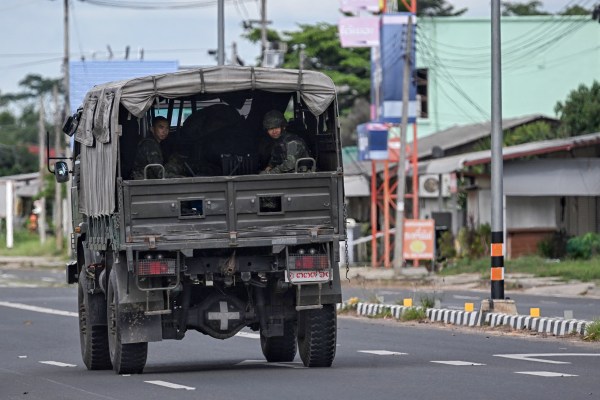Wednesday’s precision drone strike in eastern Baghdad, which killed an Iraqi militia commander the U.S. said was responsible for carrying out attacks on Americans troops, was President Joe Biden’s latest maneuver to uphold a vow he made last month. “Have no doubt—we will hold all those responsible to account at a time and in a manner [of] our choosing,” Biden said about the Iran-backed groups responsible for the deaths of three U.S. service members in a January 28 drone attack in Jordan.
But the question that analysts like former National Security Adviser John Bolton and even U.S. inspectors general are asking is: Will Biden’s retaliation be enough to deter the militants’ Iranian puppermasters?
That effort to hold responsible the culprits of recent attacks on U.S. forces and interests in the Middle East has taken multiple forms. Washington’s opening salvo began on February 2, with a series of air strikes on Iranian-backed militant sites across Iraq and Syria. The campaign hit more than 85 targets, including command and control centers, weapons storage facilities, and intelligence facilities. At least 40 people were reportedly killed in the initial wave of retaliatory attacks, including 16 members of Iraq’s Popular Mobilization Forces (PMF)—a state force made up of militias that are primarily Shiite and supported by Iran.
The following day, American and British warplanes, supported by an international coalition, struck 36 military sites across parts of Yemen controlled by Houthi rebels. The Iran-backed group of terrorists has waged war on international shipping through the Red Sea since November, attacking international merchant and naval vessels in ostensible protest of Israel’s war against Hamas in Gaza. The strikes targeting missile launchers, weapons depots, and air defense systems sought to “degrade the capabilities that the Houthis use to threaten global trade and the lives of innocent mariners,” the international coalition of eight countries wrote in a statement.
Speaking on Meet the Press the next day, White House National Security Adviser Jake Sullivan warned more would come: “We intend to take additional strikes, and additional action, to continue to send a clear message that the United States will respond when our forces are attacked, when our people are killed.”
Indeed, the U.S. military campaign against Iran-backed groups across the region continued throughout last week. In Yemen, American forces struck Houthi targets on at least six occasions, preventing imminent attacks by the militants as they prepared to launch anti-ship cruise missiles. In Iraq, Wednesday’s drone strike killed Abu Baqir Al-Saadi, a senior Kata’ib Hezbollah commander in charge of the group’s operations in Syria. The U.S. hasn’t formally accused the Iraqi militia of carrying out the strike on the Tower 22 military base in Jordan, but American officials have assessed that it had the “footprints of Kata’ib Hezbollah.”
But despite Washington’s multi-theater efforts to hold Iran’s proxies throughout the region accountable, attacks on U.S. troops and interests continue. Late Wednesday night, an American base at Syria’s Al-Omar oilfield was reportedly swarmed by suicide drones. The Houthis’ attacks in international waterways have persisted on a near-daily basis despite U.S. strikes in Yemen. And Iran’s flow of weapons and intelligence to its militias hasn’t abated, U.S. officials told NBC News last week. The Islamic Resistance in Iraq—an umbrella group of Iran-backed groups across the country—declared Friday that it would resume its operations against U.S. forces after a brief pause.
In all, there have been some 170 attacks on American troops in Iraq and Syria since October. An inspector general report released Friday found that the ongoing targeting of American and allied forces by Iranian proxies had disrupted U.S. counterterrorism operations against the Islamic State in Syria and Iraq—the reason for its military presence in the countries. It further assessed that “Iran and Iran-aligned militias will continue to attack U.S. personnel and facilities in Iraq and Syria as long as Iran does not direct a halt to these activities.”
Some analysts say the U.S. hasn’t inflicted enough pain on Iran to give it a reason to do so, pointing to its choice of targets outside the country. The five-day delay between the Biden administration’s vow to retaliate following the Tower 22 attack and initial wave of air strikes also raised eyebrows for giving the militias an opportunity to evacuate their fighters.
“The most dangerous place to be in the Middle East is an empty warehouse. They’re talking about the number of strikes rather than the impact of strikes, so there’s a quality versus quantity dynamic here,” said John Noonan, senior advisor at Polaris National Security and a former congressional staffer, who referred to the Biden administration’s response thus far as “deterrence theater” in an interview with The Dispatch.
The approach seems to be aimed at avoiding escalation with Iran, with American defense officials openly stating that they’re not seeking war with Tehran, despite its sponsorship of the groups behind continued attacks against U.S. forces. The goal hasn’t gone unnoticed in Iran: One state-run media outlet referred to the Biden administration’s military campaign as a “controlled response” and a “face-saving reaction.” Even the drone strike in Baghdad, which targeted a senior militia leader, reflected Washington’s apparent unwillingness to hit Iran and its leadership more directly.
“The administration seems unable to point the finger at the party that’s responsible for all the violence in the region, and that’s obviously Iran,” Former National Security Adviser John Bolton said in an interview with The Dispatch. “Up until now, Iran has paid no price whatsoever for everything that they’ve unleashed. Their proxies have suffered, but at some level Iran sees them as expendable. So Iran gets to violate our red lines by killing Americans, but we’re hesitant to violate their red lines by striking targets inside Iran.”
The U.S. could hit sites inside Iran to send a powerful message without threatening the regime’s survival and a wider war, Bolton insists. Among them are Iranian military bases near the Iraq border, from which Tehran has long trained and equipped the militias now carrying out attacks against U.S. forces. Another possible target is Iran’s air defenses along the border with Iraq and around the Persian Gulf.
Outside of Iran, the U.S. could target the Iranian navy, which would be particularly potent in the Red Sea, where Iranian ships have been providing intelligence that enables the Houthis’ ongoing attacks on naval and commercial ships. “Those are clear military assets, they have been violating our longstanding interest in freedom in the seas, and they would be legitimate targets,” Bolton said.
Until that more forceful U.S. response comes, Iran may see the White House’s commitment to “de-escalation” as an opportunity to test American red lines.
“While America still has a highly credible force that they can wield effectively, what they missed in redrawing the definition of traditional deterrence is the importance of will. And you see that reflected and hear that reflected in their language and the way [U.S. officials] talk about deterrence,” Noonan said. “They talk about escalation as if we’re the only contributing factor in the escalation equation—as if we get to decide whether or not things escalate, as if we have total control over whether or not things escalate. That’s simply not true. The enemy does have input in whether or not a geopolitical crisis escalates or de-escalates.”







Please note that we at The Dispatch hold ourselves, our work, and our commenters to a higher standard than other places on the internet. We welcome comments that foster genuine debate or discussion—including comments critical of us or our work—but responses that include ad hominem attacks on fellow Dispatch members or are intended to stoke fear and anger may be moderated.
With your membership, you only have the ability to comment on The Morning Dispatch articles. Consider upgrading to join the conversation everywhere.